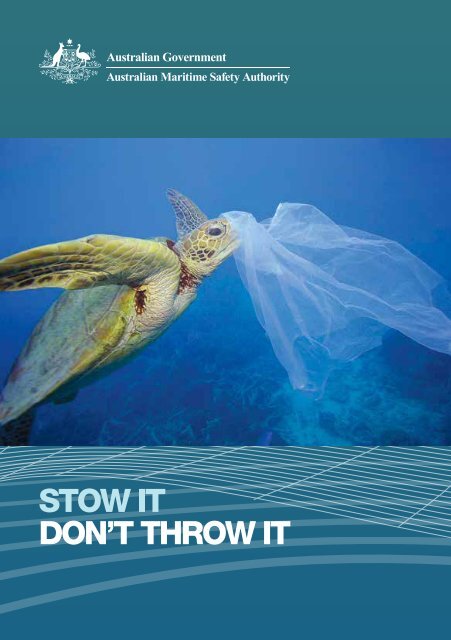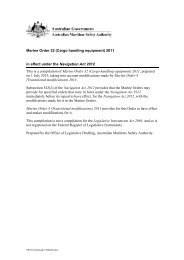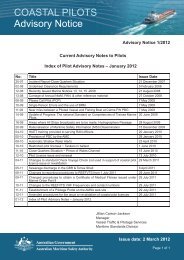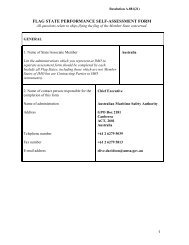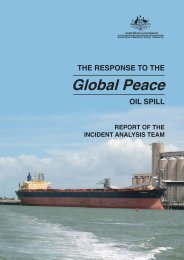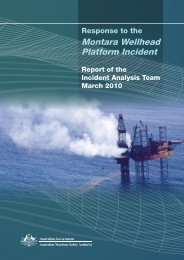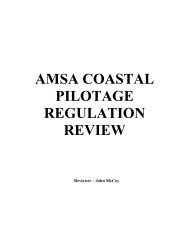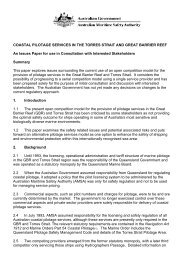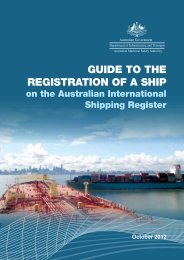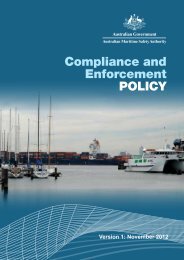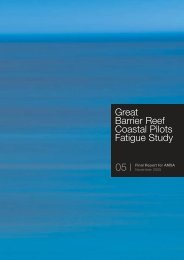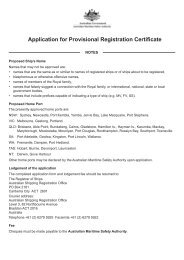Stow it don't throw it - Australian Maritime Safety Authority
Stow it don't throw it - Australian Maritime Safety Authority
Stow it don't throw it - Australian Maritime Safety Authority
Create successful ePaper yourself
Turn your PDF publications into a flip-book with our unique Google optimized e-Paper software.
<strong>Australian</strong> Mar<strong>it</strong>ime <strong>Safety</strong> Author<strong>it</strong>y<br />
<strong>Stow</strong> <strong>it</strong><br />
don’t <strong>throw</strong> <strong>it</strong>
<strong>Stow</strong> all garbage onboard<br />
The discharge of garbage from vessels can be just as deadly to marine life as oil or<br />
chemicals. Garbage discharged into the sea is not only illegal, <strong>it</strong> is not environmentally<br />
friendly and is a socially unacceptable practice.<br />
The discharge of plastics into the sea from vessels has been prohib<strong>it</strong>ed since 1988, while<br />
the discharge of other types of wastes has been perm<strong>it</strong>ted at various distances seaward<br />
from land, depending on the type of waste involved. This has now changed.<br />
From 1 January 2013, new international laws came into force that prohib<strong>it</strong>s the discharge<br />
of all types of garbage into the sea from vessels of all sizes. This includes yachts, dinghies,<br />
trawlers, fishing, recreational, tugs, ferries, general cargo, and barges amongst others.<br />
It is the responsibil<strong>it</strong>y of all seafarers and boat operators to prevent garbage from entering<br />
the sea from their vessels. Information in this booklet provides an overview of garbage and<br />
the new laws.<br />
2
The nature of garbage<br />
Garbage discharged at sea does not just disappear - <strong>it</strong> becomes marine debris and<br />
persists for months and in some cases, years (as indicated in the following table). Garbage<br />
at sea poses a major pollutant threat to the global marine environment and potentially<br />
causes damage to vessels, harm to humans and can be fatal to marine life.<br />
Time Taken For Objects To Breakdown At Sea<br />
Paper bus ticket<br />
Cotton cloth<br />
Rope (natural fibre)<br />
Woollen cloth<br />
Cigarette Butt<br />
Painted wood<br />
Tin can<br />
Aluminium can<br />
Plastic bottle<br />
2-4 weeks<br />
1-5 months<br />
3-14 months<br />
1 year<br />
1-5 years<br />
13 years<br />
50-100 years<br />
200-500 years<br />
450 years<br />
Source: Hellenic Marine Environment Protection Association (HELMEPA) & National Oceanic and Atmospheric<br />
Administration<br />
Plastics and other synthetic waste including discarded fishing gear, glass and metal are<br />
the main components of marine debris w<strong>it</strong>h an estimated seven billion tonnes entering<br />
the world’s oceans annually. Around 100,000 turtles and marine mammals such as<br />
seals, dolphins and whales and one million seabirds die each year due to ingestion and<br />
entanglement of marine debris. Discarded rope and plastic material not only poses a threat<br />
to marine life, <strong>it</strong> can damage vessels by getting caught in propeller shafts and/or block<br />
water intakes causing major damage resulting in expensive repairs and loss of income. It is<br />
the responsibil<strong>it</strong>y of everyone to ensure that no garbage is disposed of into the sea.<br />
3
The law<br />
International laws that regulate the discharge of garbage from vessels are included in the<br />
International Convention for the Prevention of Pollution from Ships (known as MARPOL)<br />
and apply to all vessels of all sizes. <strong>Australian</strong> laws implement MARPOL and impose<br />
strict controls and substantial fines for polluters. The table below provides an overview<br />
of the international laws. For more detailed guidance regarding the respective discharge<br />
requirements please refer to the text of MARPOL Annex V or to the 2012 Guidelines for the<br />
Implementation of MARPOL Annex V which are available on the AMSA webs<strong>it</strong>e.<br />
Type of garbage<br />
Food waste comminuted or<br />
ground<br />
Food waste not comminuted<br />
or ground<br />
Cargo residues* e<strong>it</strong>her<br />
contained or not contained in<br />
wash water<br />
Cleaning agents and add<strong>it</strong>ives*<br />
contained in cargo hold wash<br />
water<br />
Cleaning agents and add<strong>it</strong>ives*<br />
in deck and external surfaces<br />
wash water<br />
Carcasses of animals carried<br />
on board as cargo and which<br />
died during the voyage<br />
All other garbage including<br />
plastics, synthetic ropes,<br />
fishing gear, plastic garbage<br />
bags, incinerator ashes,<br />
clinkers, cooking oil, floating<br />
dunnage, lining and packing<br />
materials, paper, rags, glass,<br />
metal, bottles, crockery and<br />
similar refuse<br />
Mixed garbage<br />
Vessels<br />
Discharge perm<strong>it</strong>ted ≥3 nm<br />
from the nearest land, en route<br />
and as far as practicable<br />
Discharge perm<strong>it</strong>ted ≥12 nm<br />
from the nearest land, en route<br />
and as far as practicable<br />
Discharge perm<strong>it</strong>ted ≥12 nm<br />
from the nearest land, en route<br />
and as far as practicable<br />
Discharge perm<strong>it</strong>ted<br />
Discharge perm<strong>it</strong>ted<br />
Discharge perm<strong>it</strong>ted as far<br />
from the nearest land as<br />
possible and en route<br />
Discharge prohib<strong>it</strong>ed<br />
* These substances must not be harmful to the marine environment.<br />
Offshore platforms<br />
(more than 12nm from land)<br />
and all vessels w<strong>it</strong>hin 500m of<br />
such platforms<br />
Discharge perm<strong>it</strong>ted<br />
Discharge prohib<strong>it</strong>ed<br />
Discharge prohib<strong>it</strong>ed<br />
Discharge prohib<strong>it</strong>ed<br />
Discharge prohib<strong>it</strong>ed<br />
Discharge prohib<strong>it</strong>ed<br />
Discharge prohib<strong>it</strong>ed<br />
When garbage is mixed w<strong>it</strong>h or contaminated by other<br />
substances prohib<strong>it</strong>ed from discharge or having different<br />
discharge requirements, the more stringent requirements shall<br />
apply<br />
4
Penalties<br />
Where there is evidence of pollution activ<strong>it</strong>y in violation of the laws the maximum fines in<br />
the <strong>Australian</strong> legislation applicable to the MARPOL Convention are up to $17 million for<br />
companies and $3.4 million for individuals. Commonwealth and State/Northern Terr<strong>it</strong>ory<br />
legislation applies in all <strong>Australian</strong> waters including rivers, bays and estuaries.<br />
The sever<strong>it</strong>y of fines imposed by the courts takes into account the circumstances of<br />
the violation and seriousness of the type of garbage and the resulting pollution affects.<br />
Recently there have been a number of prosecutions for garbage and l<strong>it</strong>tering offences<br />
involving discharging of food waste and plastic in <strong>Australian</strong> waters resulting in fines up to<br />
$35,000. A list of garbage pollution prosecutions can be found on the AMSA webs<strong>it</strong>e.<br />
5
Types of garbage<br />
Garbage means all kinds of food wastes, domestic wastes and operational wastes such<br />
as all plastics (including degradable plastics), cargo residues, incinerator ashes, cigarette<br />
butts, deck sweepings, wood, cooking oil, bottles, any paper products including cardboard,<br />
crockery, dunnage, lining and packing materials, rags, metal, crockery, glass, aluminium<br />
tins , fishing gear (line, nets, traps, floats etc), and animal carcasses generated during the<br />
normal operation of a vessel.<br />
All materials that are considered to be waste and are no longer of use onboard the vessel,<br />
need to be disposed of properly at shore facil<strong>it</strong>ies. Some of these materials can be recycled<br />
and reused and placed in appropriate bins and/or facil<strong>it</strong>ies.<br />
6
Fishing vessels<br />
Fishing vessel operators must comply w<strong>it</strong>h the general garbage discharge requirements but<br />
also have an added responsibil<strong>it</strong>y related to pollution at sea.<br />
The added responsibil<strong>it</strong>y involves accidental discharges or loss of fishing gear such as<br />
trawl, gill and other fishing nets or line scraps that pose significant threat to the marine<br />
environment. This discharge of gear can also create a navigational hazard that may cause<br />
damage and affect the safety of other vessels.<br />
Fishing gear should have degradable panels of natural material to reduce the potential for<br />
entanglement of marine life if the gear is lost. Operators are also encouraged to utilise gear<br />
identification systems to assist recovery and return of lost gear. Fishers are encouraged to<br />
make every effort to retrieve lost gear and other persistent garbage found at sea, if safety<br />
practices allow.<br />
If garbage or fishing gear is accidentally discharged or lost, the circumstances should be<br />
recorded in the vessel’s Official Logbook or Garbage Record Book. If large amounts of<br />
fishing gear are lost, the approximate pos<strong>it</strong>ion and reasons for the loss should be reported<br />
to AMSA’s Rescue Coordination Centre (RCC - Australia). This allows other vessels to look<br />
out for the lost gear and avoid, or retrieve if practical.<br />
Where available, motherships may provide waste services free of charge to fishing vessels<br />
including receiving recyclable garbage and waste oil for financial benef<strong>it</strong>, often donated to<br />
commun<strong>it</strong>y services.<br />
7
Signage required on all vessels >12 metres<br />
All vessels of 12 metres or more in length are required by law to display signs or placards<br />
that provide information about the garbage laws. The signs should be visible in all areas<br />
onboard the vessel where garbage is generated or stored and in full view of crew and<br />
passengers. The wording for the signs should be similar to the following examples. 1<br />
INTERNATIONAL POLLUTION REGULATIONS<br />
MARPOL CONVENTION ANNEX V<br />
DISCHARGE OF GARBAGE INTO THE SEA IS<br />
PROHIBITED<br />
Garbage should be retained on board for discharge at port reception facil<strong>it</strong>ies or other services.<br />
Violation of these requirements may result in penalties<br />
Discharge of the following garbage is only perm<strong>it</strong>ted while the ship is ‘en route’ and as far as practicable from the nearest land.<br />
FOOD WASTE COMMINUTED through equipment w<strong>it</strong>h<br />
More than 3nm from nearest land<br />
particle size no greater than 25mm*<br />
FOOD WASTE that has not been processed<br />
More than 12 nm from nearest land<br />
CARGO RESIDUES not harmful to the marine environment*<br />
CLEANING AGENTS/ADDITIVES from cargo hold, deck and external<br />
surfaces washing water, *not harmful to the marine environment*<br />
ANIMAL CARCASSES<br />
As far from the nearest land as possible<br />
SPECIAL AREAS including ANTARCTIC AREA<br />
Add<strong>it</strong>ional restrictions apply.<br />
Refer to MARPOL Annex V<br />
FOOD WASTE COMMUNITED - More than 12 nm from<br />
nearest land or ice shelf<br />
Discharge of introduced avian products PROHIBITED in<br />
Antarctic Area unless incinerated, autoclaved or otherwise<br />
treated to be made sterile.<br />
Garbage can be incinerated in equipment complying w<strong>it</strong>h MARPOL Annexes V and VI.<br />
All discharges must be recorded in the Garbage Record Book.<br />
All Seafarers must follow procedures for handling garbage in accordance w<strong>it</strong>h the Garbage Management Plan.<br />
Note: Cooking oil is not considered food waste and cannot be discharged into the sea.<br />
*Refer to MARPOL Annex V and guidelines for defin<strong>it</strong>ion of ‘nearest land’, guidance on the discharge of animal carcasses and<br />
substances harmful to the marine environment.<br />
NOTE: All waste on board a ship entering <strong>Australian</strong> waters is classified as Biosecur<strong>it</strong>y Risk Material (BRM)<br />
and must not be discharged of into the sea w<strong>it</strong>hin the 12nm lim<strong>it</strong>.<br />
INTERNATIONAL POLLUTION REGULATIONS<br />
MARPOL CONVENTION, ANNEX V<br />
DISCHARGE OF GARBAGE INTO THE SEA IS<br />
PROHIBITED<br />
• All garbage should be retained on board and disposed at facil<strong>it</strong>ies on<br />
land, in port or marina.<br />
• Food waste can be legally discharged at sea provided the vessel is<br />
moving and is more than 12 nautical miles from the nearest land.<br />
• For vessels of 100 gross tonnage and above, refer to the Garbage<br />
Management Plan.<br />
• Fishing and tourist vessels are allowed to release small amounts of food<br />
into the sea for the purpose of fish feeding or tourist operations.<br />
Note: Cooking oil is not considered food waste<br />
and cannot be discharged into the sea<br />
Violations of these requirements may result in penalties.<br />
8<br />
1 Vessel operators can make their own sign or use stickers produced by AMSA and other author<strong>it</strong>ies to assist in meeting<br />
this requirement
Records and plans required on certain vessels<br />
Garbage management plan<br />
Vessels 100 gross tonnage and above, and every ship which is certified to carry 15 or more<br />
persons, and fixed and floating platforms are required to carry a garbage management<br />
plan. The plan must contain procedures for collecting, storing, processing and disposal<br />
of garbage. It should designate the person/persons in charge of carrying out the plan. The<br />
plan must be wr<strong>it</strong>ten in the working language of the vessels crew and all crew must follow<br />
the procedures in that plan. 2<br />
Garbage record book<br />
Vessels 400 gross tonnage and above and those vessels certified to carry 15 or more<br />
people are required to maintain a Garbage Record Book and enter details of every garbage<br />
discharge to shore facil<strong>it</strong>ies or perm<strong>it</strong>ted discharge at sea in this book. The record book<br />
must be kept onboard for a minimum of two years and be available for inspection by<br />
author<strong>it</strong>ies. 3<br />
2 The format for a garbage management plan is available from the AMSA web s<strong>it</strong>e: www.amsa.gov.au/environment/<br />
legislation-and-prevention/garbage-management-plans/<br />
3 Garbage record books can be purchased from AMSA.<br />
9
Managing waste onboard<br />
Vessel operators need to plan ways to reduce the amount of garbage onboard. This can<br />
be done by careful planning on what is taken to sea and will assist to minimise garbage<br />
generation onboard. Using crockery instead of disposable paper cups and plates and<br />
reducing the amount of plastics by using bulk packaging of consumables can assist.<br />
Compacting or crushing garbage will take up less storage space on the vessel until<br />
returning to land and disposing of at shore facil<strong>it</strong>ies.<br />
Onboard separation and storage of materials is recommended for reuse or recycling w<strong>it</strong>h<br />
delivery to appropriate bins or facil<strong>it</strong>ies onshore. Recycling of some materials such as<br />
aluminium cans may have a financial benef<strong>it</strong> when disposed of at shore facil<strong>it</strong>ies<br />
in certain states.<br />
Food waste can be directly discharged into the sea if the discharge occurs at the specified<br />
distance from the nearest land as perm<strong>it</strong>ted under the law. If this distance is not reached<br />
during operations, all food waste needs to be stored onboard by e<strong>it</strong>her double bagging<br />
and/or freezing (if a freezer is onboard) until <strong>it</strong> can be disposed of at shore facil<strong>it</strong>ies.<br />
THINK REDUCE REUSE RECYCLE<br />
10
Shore facil<strong>it</strong>ies<br />
Under the international laws there is an obligation upon Australia to provide facil<strong>it</strong>ies<br />
to receive all types of waste from vessels. This includes all types of garbage, oil,<br />
chemicals and sewage. Facil<strong>it</strong>ies are required to be appropriate and adequate for the<br />
vessel activ<strong>it</strong>ies in the area. Facil<strong>it</strong>ies should be available at marinas, wharves, fishing<br />
cooperatives, berths and ports. The type of facil<strong>it</strong>y will range from bins or skips emptied<br />
by local councils or contractors to barge collection services and pump out operations.<br />
If there are no facil<strong>it</strong>ies available for the disposal of garbage, the marina/wharf owner<br />
or port author<strong>it</strong>y should be contacted. The state/terr<strong>it</strong>ory and local officials should also<br />
be notified of any inadequate facil<strong>it</strong>ies. Where enough people express concern, <strong>it</strong> is<br />
reasonable to expect upgrading of services.<br />
More information<br />
For more information on mar<strong>it</strong>ime garbage laws and the requirements, contact the local<br />
state marine/port/ transport author<strong>it</strong>y or<br />
Marine Environment Division<br />
<strong>Australian</strong> Mar<strong>it</strong>ime <strong>Safety</strong> Author<strong>it</strong>y<br />
GPO Box 2181<br />
CANBERRA ACT 2601<br />
Email: eps@amsa.gov.au<br />
See also www.amsa.gov.au<br />
Photographs courtesy of<br />
Kristy Theissling - Penguin picture<br />
Troy Mayne -Turtle picture<br />
Tangaroa Blue Foundation<br />
<strong>Australian</strong> Mar<strong>it</strong>ime <strong>Safety</strong> Author<strong>it</strong>y<br />
Mar<strong>it</strong>ime <strong>Safety</strong> Queensland<br />
Cynthia Vanderlip - Algal<strong>it</strong>a Marine<br />
Research Foundation<br />
US Center for Marine Conservation<br />
11
You can help<br />
The protection of the marine environment is the responsibil<strong>it</strong>y of everyone. Be aware<br />
of the threats to our waterways and oceans and of the serious effects pollutants can<br />
have on the marine environment.<br />
REPORT all illegal discharges of garbage to the local author<strong>it</strong>ies or to AMSA. Be<br />
sure to get the vessel’s name or number, the location gps of the discharge and a<br />
description of the type of garbage discharged. Take photographs or collect the<br />
garbage if possible. This is useful for further investigation and possible prosecution of<br />
the polluters.<br />
If w<strong>it</strong>nessing a vessel polluting, reports can be made to AMSA’s Rescue Coordination<br />
Centre (RCC) in Canberra.<br />
FREECALL: 1800 641 792<br />
Phone: 02 6230 6811<br />
Facsimile: 02 6230 6868<br />
www.amsa.gov.au<br />
AMSA 260 (6/13)


